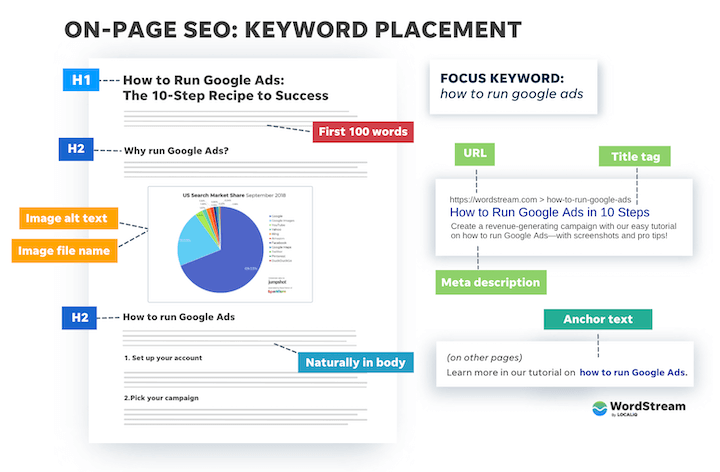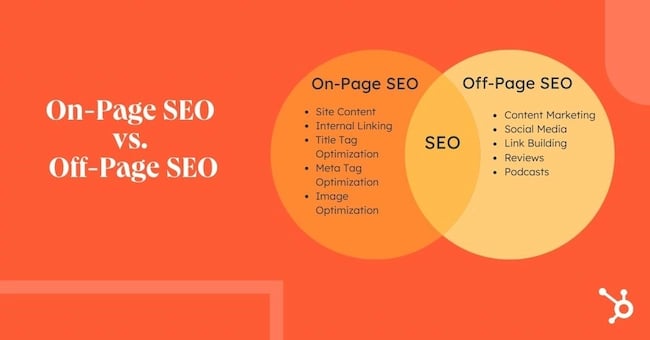Unlock the secrets of boosting your website’s visibility with our comprehensive guide to mastering on-page SEO tactics and strategies.

Image courtesy of via DALL-E 3
Table of Contents
Introduction to On-Page SEO
Welcome to the exciting world of On-Page SEO! In this section, we will explore what On-Page SEO is all about and why it plays a crucial role in enhancing the visibility of websites and blogs on search engines.
What is On-Page SEO?
On-Page SEO, short for On-Page Search Engine Optimization, involves optimizing individual web pages to improve their search engine rankings and attract more organic traffic. Essentially, it’s about making sure each page on your website is easily discoverable and understandable by search engines like Google.
Why On-Page SEO is Important?
On-Page SEO is vital because it helps search engines understand the content of your website, which in turn helps people find your website when they search for relevant terms. By optimizing your pages effectively, you can increase your chances of appearing higher in search results and attracting more visitors to your site.
Choosing the Right Keywords
Keywords are the specific words or phrases that people type into search engines like Google when they are looking for information. These words are crucial because they help search engines understand what your content is about and match it with the right audience.
How to Find Good Keywords
Finding good keywords is essential for making sure your content gets seen by the right people. One simple way to find keywords is to think about what words someone might use to search for the topic you are writing about. You can also use tools like Google’s Keyword Planner or other keyword research tools to see what terms are popular.
Creating Great Titles and Headlines
In this section, we will explore how to craft catchy titles and headlines for your blog posts that grab readers’ attention.
Why Titles and Headlines Matter
Good titles and headlines are crucial because they are the first thing people see when they come across your blog post. They need to be interesting and compelling to make readers want to click and read more. Think of them as the gateway to your content.
Tips for Writing Catchy Titles
Here are some simple tips to help you create captivating titles and headlines for your blog posts:
1. Make it fun: Add some humor or wit to your titles to make them more enjoyable to read.
2. Ask a question: Pose a question in your title to pique readers’ curiosity and make them want to find out the answer.
3. Keep it short and sweet: Try to keep your titles concise and to the point. Long titles can be overwhelming and may not grab as much attention.
4. Use strong language: Words like “amazing,” “essential,” or “unbelievable” can make your titles more compelling and persuasive.
By following these tips, you can create engaging titles and headlines that will entice readers to click on your blog posts and explore your content further.
Writing Quality Content
When running a blog, one of the most important aspects to consider is the quality of the content you provide to your readers. Quality content not only keeps your audience engaged but also helps in attracting more visitors to your website. Let’s delve into what makes content great and how you can ensure your blog posts are informative and engaging.

Image courtesy of www.wordstream.com via Google Images
What Makes Content Quality?
Quality content is characterized by several key elements that make it stand out. Firstly, it should be clear and easy to understand. By using simple language and organizing your ideas logically, you can ensure that your readers grasp the message you’re trying to convey.
Additionally, good content is fun to read. Injecting a bit of personality into your writing, using humor where appropriate, and keeping your readers entertained are essential in maintaining their interest throughout the article.
Lastly, quality content is helpful. Whether you’re sharing valuable information, providing tips and tricks, or offering solutions to common problems, ensuring that your content adds value to your readers’ lives is crucial in keeping them coming back for more.
How to Engage Your Readers
Engaging your readers is key to building a loyal following for your blog. One way to do this is by incorporating interactive elements into your content. This could be in the form of fun facts, quizzes, or polls that encourage your readers to participate and engage with your content.
Another effective strategy is to tell a story. Humans are naturally drawn to narratives, so weaving a compelling story into your blog posts can captivate your audience and keep them hooked until the end.
Remember, the ultimate goal of writing quality content is to create a positive experience for your readers. By focusing on clarity, entertainment, and helpfulness, you can ensure that your blog posts resonate with your audience and keep them coming back for more.
Using Images and Videos
Incorporating images and videos into your blog can significantly enhance the overall appeal and effectiveness of your content. Visual elements not only make your blog posts more engaging but also help convey information in a more compelling manner. Let’s explore why using images and videos is crucial for creating impactful blog posts.
Why Use Images and Videos?
Images and videos play a vital role in capturing the attention of your audience. A well-chosen image or an engaging video can instantly draw readers in and make your content more visually appealing. Visual content breaks up blocks of text, making your blog posts easier to read and understand, especially for younger readers like yourself. Additionally, images and videos can help illustrate complex ideas or concepts, making them more comprehensible.
Choosing the Right Images and Videos
When selecting images and videos for your blog posts, it’s essential to ensure they align with your content and enhance the overall message you want to convey. Here are a few tips to help you pick the right visual elements:
1. Relevant: Choose images and videos that are directly related to the topic you’re discussing. This helps maintain coherence and reinforces your message.
2. High quality: Opt for clear, high-resolution images and well-produced videos to maintain a professional appearance and engage your audience effectively.
3. Captivating: Select visuals that are eye-catching and compelling to draw readers’ attention and keep them interested in your content.
By carefully selecting and incorporating images and videos into your blog posts, you can create a more immersive and enjoyable reading experience for your audience.
Internal and External Links
Links are an essential part of creating a well-structured and informative website. In this section, we will discuss the importance of both internal and external links and how they can improve the quality and visibility of your website.

Image courtesy of www.sprintzeal.com via Google Images
What are Internal Links?
Internal links are hyperlinks that connect different pages within your website. These links help users navigate your site easily and allow search engines to understand the hierarchy and relationship between different pages. By linking relevant pages together, you can improve the user experience and keep visitors engaged on your website for longer periods.
The Importance of External Links
External links, also known as outbound links, are hyperlinks that point to other websites. While internal links help users navigate within your site, external links provide additional information and credibility to your content. When you link to reputable websites, it shows search engines that you value quality information and can improve your website’s trustworthiness and authority.
Meta Descriptions and Tags
A meta description is a brief summary of your webpage content that appears underneath the title in search engine results. It helps search engines understand what your page is about and allows users to decide whether to click on your link.
How to Write Effective Meta Descriptions
To write an effective meta description, keep it concise and engaging. Include relevant keywords and provide a compelling reason for users to click on your link. Make sure it accurately reflects the content of your page to avoid misleading visitors.
Monitoring and Improving Your SEO
In order to make sure your website is easily found by search engines and attracts more visitors, it’s crucial to monitor and continuously improve your SEO efforts. By keeping track of the performance of your site and making necessary adjustments, you can enhance your online visibility and reach a wider audience.

Image courtesy of blog.hubspot.com via Google Images
Using Tools to Monitor SEO
There are simple tools available that can help you keep track of how well your SEO strategies are working. These tools provide valuable insights into the performance of your website, such as the number of visitors, popular keywords, and the overall ranking on search engine results pages.
Continually Improving Your SEO
Once you have gathered data from monitoring tools, it’s essential to analyze the results and identify areas that need improvement. By understanding which keywords are driving traffic, which pages are performing well, and where there is room for enhancement, you can tailor your SEO tactics to increase the effectiveness of your website.
Summary
In this comprehensive guide to On-Page SEO, we’ve covered the essential aspects of optimizing your website and blog to improve visibility on search engines like Google. Let’s quickly revisit the key points discussed in each section:
Main Points Recap
On-Page SEO involves optimizing individual pages on your website to make them more visible to search engines like Google. By choosing the right keywords, creating engaging titles and headlines, writing quality content, using images and videos, incorporating internal and external links, crafting effective meta descriptions and tags, and continually monitoring and improving your SEO, you can boost your website’s ranking and attract more visitors.
Remember, good SEO practices involve understanding what your audience is looking for and providing valuable, relevant content that meets their needs. By following the strategies outlined in this guide, you can enhance your online presence and drive more traffic to your website.
Want to turn these SEO insights into real results? Seorocket is an all-in-one AI SEO solution that uses the power of AI to analyze your competition and craft high-ranking content.
Seorocket offers a suite of powerful tools, including a Keyword Researcher to find the most profitable keywords, an AI Writer to generate unique and Google-friendly content, and an Automatic Publisher to schedule and publish your content directly to your website. Plus, you’ll get real-time performance tracking so you can see exactly what’s working and make adjustments as needed.
Stop just reading about SEO – take action with Seorocket and skyrocket your search rankings today. Sign up for a free trial and see the difference Seorocket can make for your website!
Frequently Asked Questions (FAQs)
Common SEO Questions
Here are some common questions you might have about On-Page SEO:
What is On-Page SEO?
On-Page SEO is all about making each page on your website better so that search engines can easily find it. It involves optimizing your content, titles, images, and more to improve your website’s visibility on search engines like Google.
Why is On-Page SEO Important?
On-Page SEO is crucial because it helps people find your website when they search for relevant topics online. By optimizing your pages, you increase the chances of your website appearing higher in search results, which can lead to more visitors and engagement.
What are Keywords and Why are They Important?
Keywords are the words or phrases that people use when searching for information on the internet. By incorporating relevant keywords into your content, titles, and meta descriptions, you can improve your website’s visibility on search engines like Google, making it easier for your target audience to find you.
How Can I Find Good Keywords?
You can find good keywords by using tools like Google Keyword Planner or SEMrush to see what terms people are searching for related to your topic. Additionally, you can look at your competitors’ websites to identify popular keywords they are using successfully.
Why Do Titles and Headlines Matter?
Titles and headlines are essential because they are the first things that people see when they come across your content. Engaging titles and headlines can grab the reader’s attention, spark their curiosity, and encourage them to click through to read more.
How Can I Engage My Readers?
You can engage your readers by creating content that is informative, interesting, and relevant to their needs. Use storytelling, statistics, and interactive elements like quizzes or polls to keep your audience engaged and coming back for more.
Why Should I Use Images and Videos?
Images and videos can enhance your content by making it visually appealing and easier to understand. Visual elements can break up large blocks of text, convey information quickly, and engage your audience in a more interactive way.
What are Internal and External Links?
Internal links connect different pages on your website, helping search engines navigate and index your site more effectively. External links, on the other hand, refer to hyperlinks that point to other websites, providing additional information or resources for your readers.
How Do Meta Descriptions and Tags Help with SEO?
Meta descriptions are short summaries that appear below the title of your page in search engine results. They provide a preview of what your content is about, helping users decide whether to click on your link. Tags help categorize and organize your content, making it easier for search engines to understand and index your pages.
How Can I Monitor and Improve My SEO?
Monitoring tools like Google Analytics can help you track the performance of your website and identify areas for improvement. By analyzing data such as traffic sources, user engagement, and keyword rankings, you can make informed decisions to optimize your content and enhance your website’s overall SEO.







